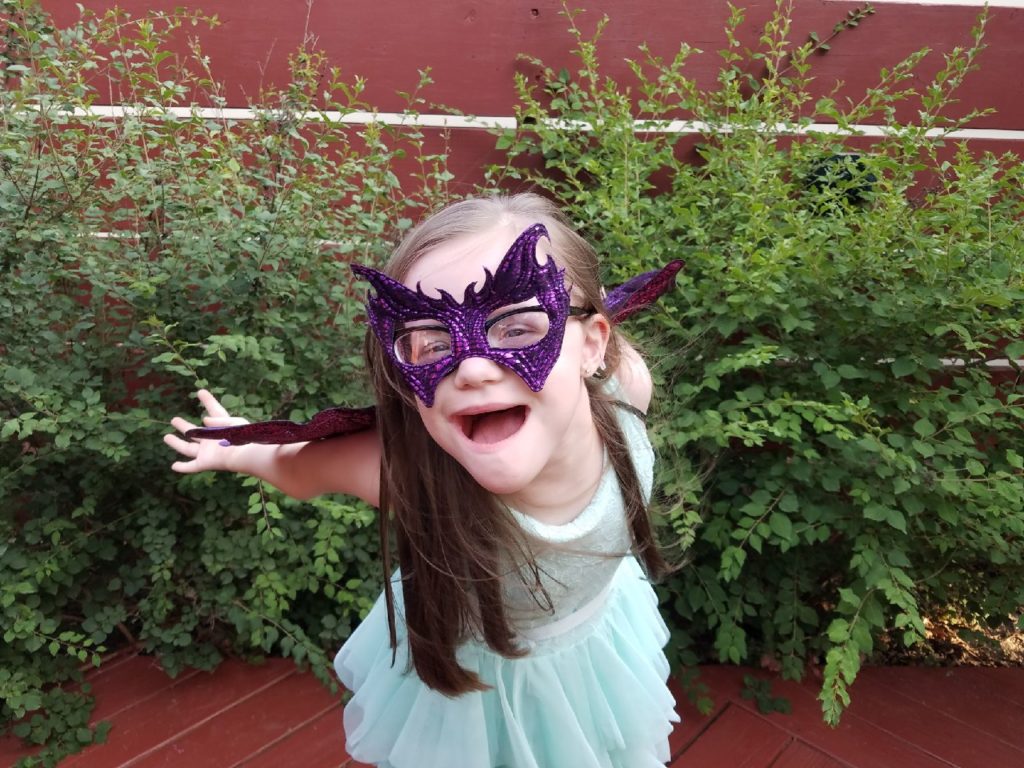A little acrostic poetry for your Wednesday morning.
And a couple of variations:
To get more great content from These Small Wonders, follow us on social media or subscribe to get email notifications with new posts.
A blog about Down syndrome, disability and the value of a life
by Tom Brown
A little acrostic poetry for your Wednesday morning.
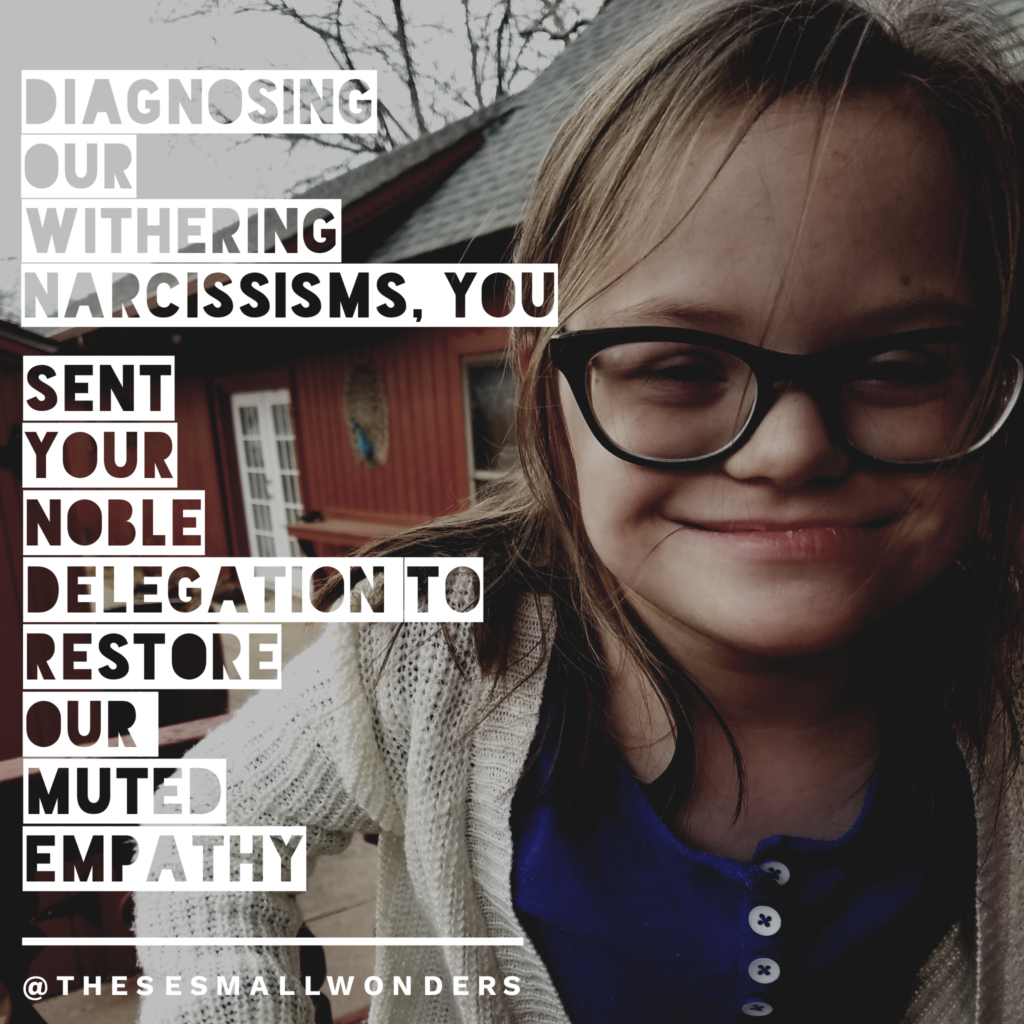
And a couple of variations:
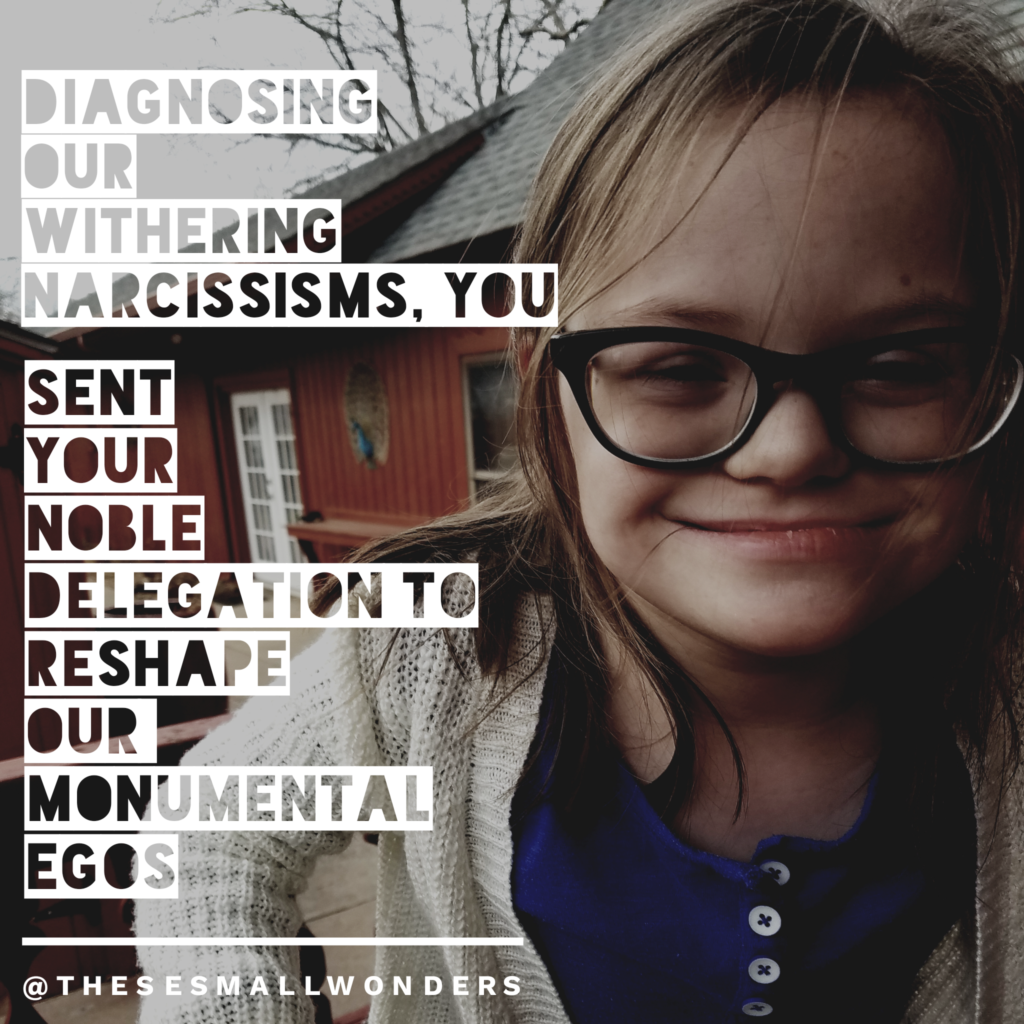
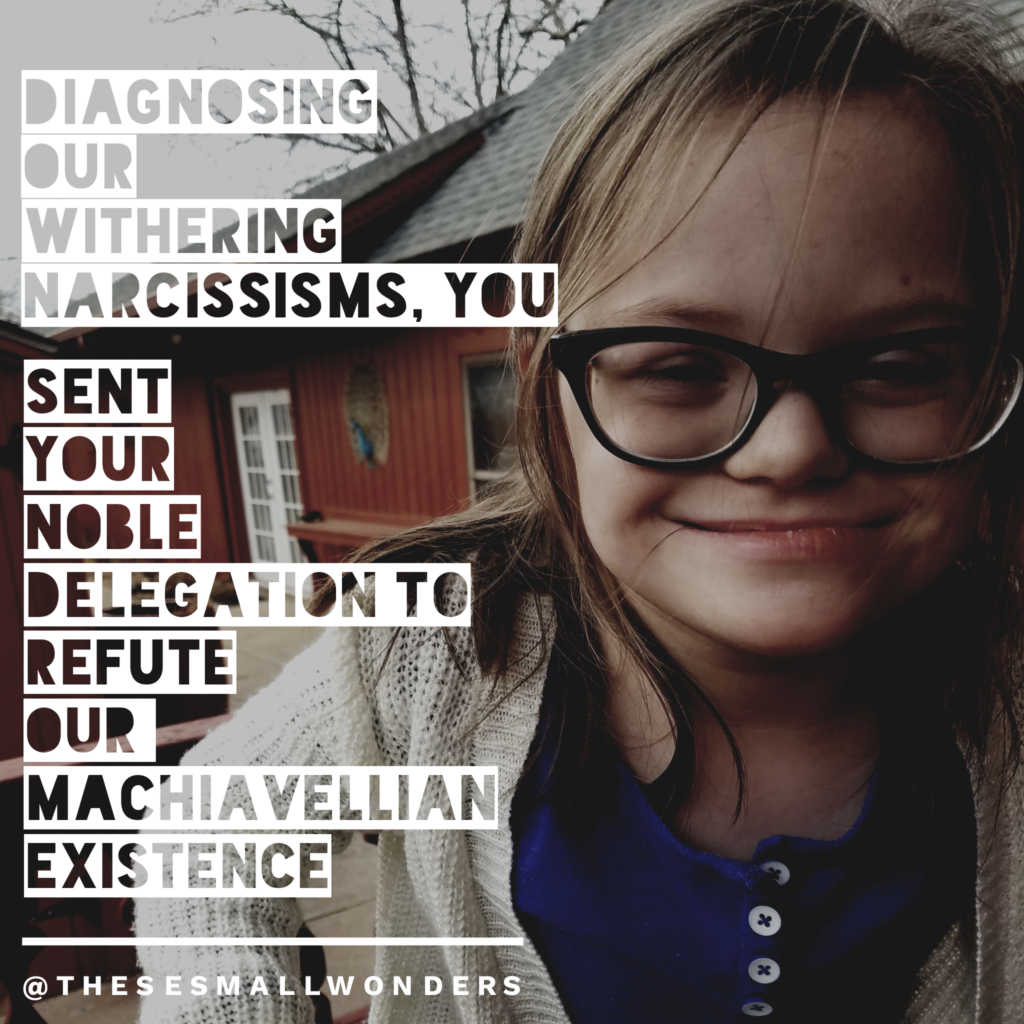
To get more great content from These Small Wonders, follow us on social media or subscribe to get email notifications with new posts.
by Tom Brown
This post is directly addressed to anyone who will face the question: what does my child’s disability say about me? About my life? If that is you or someone close to you, you know the intensity of the question.
But we of the diagnoses aren’t the only ones who wrestle intensely with the hard questions of life and identity. The deep soul searching incited by our touches with disability comes from a place which exists inside us all. Crises of the self are common to all of humanity. So, indirectly, I suppose this post relates to everyone.
To attempt an answer to our question, I’ll tell you a story.
Heath White is a former Air Force pilot who currently works for the FBI. In his free time, he raises cattle with his family at their home in East Texas. He also runs marathons while pushing wheelchairs loaded with people who cannot run on their own feet.

I was introduced to White through an ESPN E:60 feature about his running which went viral a few years ago.
He is a man in motion, full of energy and exuding love for people with special needs, especially his daughter Paisely. When I contacted him to talk about the story, he was more than willing to give away his time – “I’ll do anything for the community.” You believe him when he says that.
He’ll drop everything to take a phone call or book a flight to support an event, anything, if he can help a person or a family with special needs. He strikes you as a man who knows who he is and lives with purpose.
If you only knew Heath a decade ago, you probably wouldn’t recognize him today.
Rewind a few years and you’ll find a man entering into the prime of his life, overflowing with the kind of confidence that can only come from years of winning. He had a star athletic career under his belt, a beautiful wife in his arms, a healthy baby in the crib and a job people write movies about. Guys look at a man like that and think, “I want what he has.”
That’s exactly what Heath wanted. The perfect life, an enviable life. And it was unfolding around him. It was unfolding perfectly, until, in one disastrous moment, an unforeseen variable entered the equation and threatened the whole perfect formula.
A flagged ultrasound during the Whites’ 2nd pregnancy led to an amniocentesis test which revealed the marks of an extra copy of the 21st chromosome. The little girl in the womb showed undeniable signs of a disabling error in her DNA. There was a glitch in the transmission of the Whites’ healthy, beautiful and successful genetic coding.
The news was unbearable and unacceptable for Heath.
A man reared in the world of cattle, he knew that when there is a flaw in the offspring, the bull takes the blame. The news of his daughter’s broken genetics was a tarnish on his image that he couldn’t tolerate. His reputation as a winner, big time stock, was on the line.
So Heath did what many in his shoes have done. He demanded an abortion.
White is not alone in his reaction to the unwanted imposition of disability into his life plans.
The realization that my daughter was disabled came with a singular shock in my own life. Before Elizabeth, I had only seen Down syndrome from a distance, as an abstraction, but nothing more. Then my daughter slipped through the prenatal testing gauntlet to crash into our world with a face unlike anything we imagined.
That morning, when I held my daughter in my arms, I looked into the eyes of Down syndrome and, for the first time, it was mine. It belonged to me. It appeared out of nowhere and suddenly, irrevocably entangled itself into the fabric of my heart. Down syndrome, disability, was no longer a concept ‘out there’. It was my daughter, my family, it was me.
That mind-altering realization comes haunted with a question.
What does this say about me? What does this say about my life?
Most of us carry an image of an ideal identity, the perfect life. We spend massive amounts of time and energy building our lives around those images – Successful. Wealthy. Beautiful. Strong. Free.
But behind those structures we build, other images linger. Darker ones we don’t want to think about and from which we will run at all costs. Weak. Unattractive. Unwanted. Unworthy. Trapped.
It’s hard to tell which is more motivating – the promise of perfection or the threat of imperfection’s exposure. In the age of digital personal branding, the pressure to achieve the ideal can be enormous.
Whether we are running from or running towards an image, as long as we are running, we’ll never know who we really are. Our lives will not be authentic, and therefore they will be fragile.
Maybe this is one of the things that makes a diagnosis of disability so emotionally crushing.
When Heath White first heard the words Down syndrome, his main concern was “what will people think about me? What weakness inside me caused that?”
Looking back, he describes himself in those days with two adjectives his former self would never have admitted to: scared and selfish. Running from his fears, running from the terrifying prospect of weakness, he demanded the termination of what he could only perceive as a threat.
So what happened next?
You can imagine the tension his response created for Heath’s wife, Jennifer. Her husband meant the world to her, she understood and shared his pain, yet ending the life of the child in her womb would set her against everything she valued and believed in.
In the end, after agonizing hours of deliberation and prayer, she gave him her answer – “get on board and be the man you should be or leave.” My child will live.
The unmovable will of a mother won the day and a few months later the couple came face to face with their daughter. Paisely White. A soft little ball of humanity who came into Heath’s life like a blast of dynamite – shattering the facade of a perfect life. Leaving a pile of broken pieces.
As Heath tried to come to terms with his new reality, one moment opened his eyes to an entirely new perspective and provided a framework to rebuild a life. One very ordinary day, while tickling Paisely, he noticed that she giggled and struggled to push his hands away just like her older sister. In that moment, Heath’s grip on his dream life and his resistance to the imperfection of his daughter’s genetics broke.
This is my daughter.
That was the beginning of an epic transformation. Having faced his fears and accepted his losses, Heath was free to truly see his daughter, not as a threat to his identity, but as his beloved child, a unique and captivating little human who had stolen his heart. And he had to tell the world about it. So he decided to run a road race with Paisely and publicly declare his pride for her.
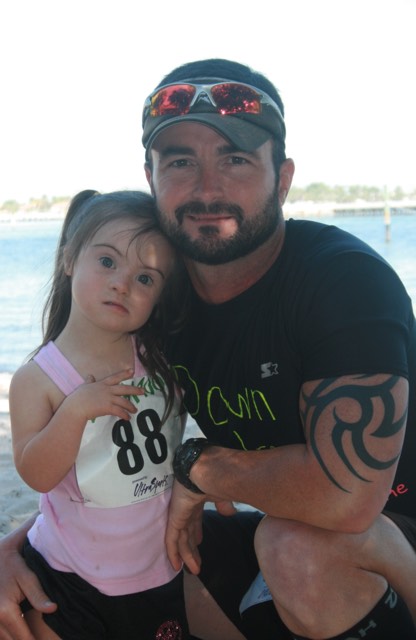
Together, they ran a 50k ultra-marathon. They came in 2nd place. A few days after the race, Heath got a phone call from a producer at ESPN. “Yeah right, this is ESPN.” It really was ESPN, and they wanted to feature the Whites on E:60. Heath got his chance to show off his little girl – to millions of people, all over the globe.
Today, Heath no longer runs with his daughter. When he and Paisely reached an impressive tally of 321 miles together (the numbers representing 3 copies of the 21st chromosome), Heath realized that he had accomplished his goal for the races.
Now his oldest daughter is the one who runs with Paisely. (She’s planning on becoming a therapist for kids with disabilities.)
After the thrill of running with the kind of purpose he had found with Paisely, running solo just didn’t offer the satisfaction it once had. So he found others with special needs who wanted to experience the joy of racing and added new partners to his team.
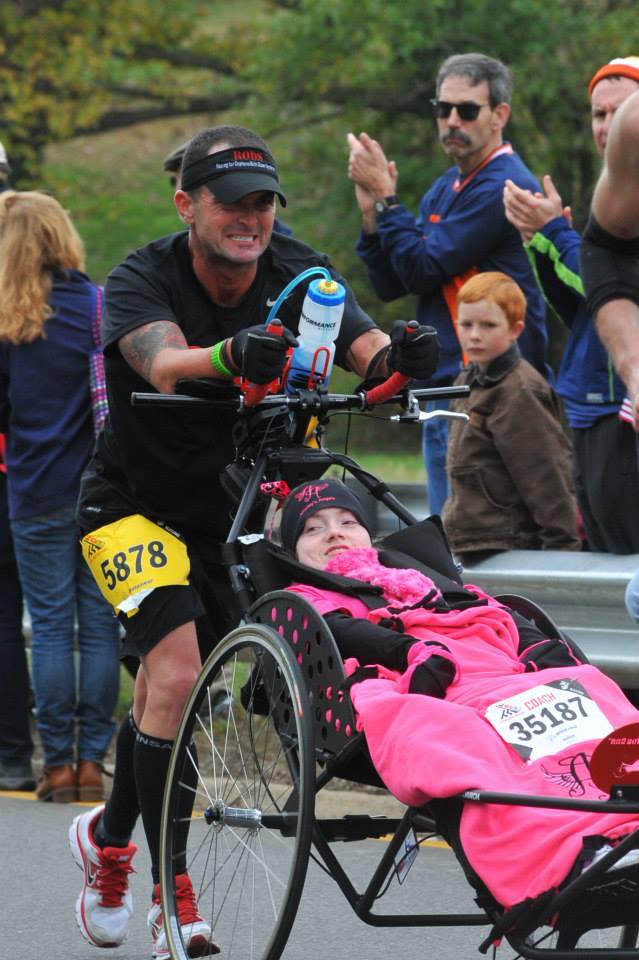
One of those partners is Gabby, a girl with Cerebral palsy who was featured on another E:60 piece. After seeing her story, Heath contacted his producer to make a connection. When Gabby’s Mom watched Heath’s video, her initial reaction was “I don’t want to talk to him. That guy’s a jerk!” But she gave him a chance and, to date, Heath and Gabby have run 10 marathons together, including Boston.
In one of the recent races, Gabby had the option – do you want to take it easy or do you want to go fast today? She replied, “I want to win.” Twenty miles in Gabby turned back and shouted “Heath, it’s time for beast mode.” That day they were 4 minutes off of Heath’s solo PR. Beast mode indeed. During the race, Gabby told him, “Today I’m like a butterfly. I’m not disabled, I’m just like everybody else.”
Those are the moments he lives for.
It’s astonishing to see the results of this transformation. Heath’s as driven and successful as ever, but he’s using that drive to lift others instead of his own image. A man who was once running, scared and selfish, is now a hero to millions who runs with purpose and conviction, straight towards imperfect people.
When you ask Heath what he thinks about when he runs, he’ll describe for you a scene he imagines will take place someday in heaven.
He imagines himself coming to a set of gates where he is welcomed by Jesus, who tells him “get on in here Heath, there are some people who want to see you.” He’s then taken into a packed banquet hall. He sees that the people are not at all typical – the women are supermodel-beautiful, the guys are tall, dark and rippling with muscle. “These are not my people. I’m in the wrong room” he thinks. Then, one of the women, drop dead gorgeous, walks up and says “Dad, it’s me Paisely. These are all the kids that you pushed. Up here we look on the outside like we did on the inside down there.”
This is the vision that drives White’s sacrifices for people with special needs.
He will stop me here and say, “that’s not it. It’s not that I’m doing something great for them. It’s the other way around. They’re helping me.”
“I’ve come to realize that I need them way more than they need me. If I go for a couple of months without pushing anybody, I just feel stale and stagnant. Like ‘why am I even here?’ Who can I run with next? There’s gonna be some lesson for me to learn from this person.”
Heath once thought he was losing his perfect life. Now he knows it was never perfect to begin with. “Everything I’ve done. Everything I’ve tried to accomplish. It was never going to be perfect. My love for Paisely is perfect.”
What does it say about you if you’re child is diagnosed with disability? What does it say about your life? I asked Heath how he would answer the question.
“It says God picked you for a reason.”
When Paisely was born, this was his grandfather’s word of wisdom – “Boy, God doesn’t give those babies to just everybody. He picked you for a reason. You may not see the reason, but He does.”
Now Heath gives out the same advice. “God picked you for a reason. And you don’t know it right now, you might not know it for years to come. But you gotta be open to seeing the good in it and to learning the lesson that He’s going to teach you.”
This is the lesson so many of us have learned through our kids:
You don’t have to be perfect to be loved. You don’t have to be typical to be beautiful. Love is far stronger and more satisfying than anything else you can achieve in this life.
It’s a lesson that changes everything.
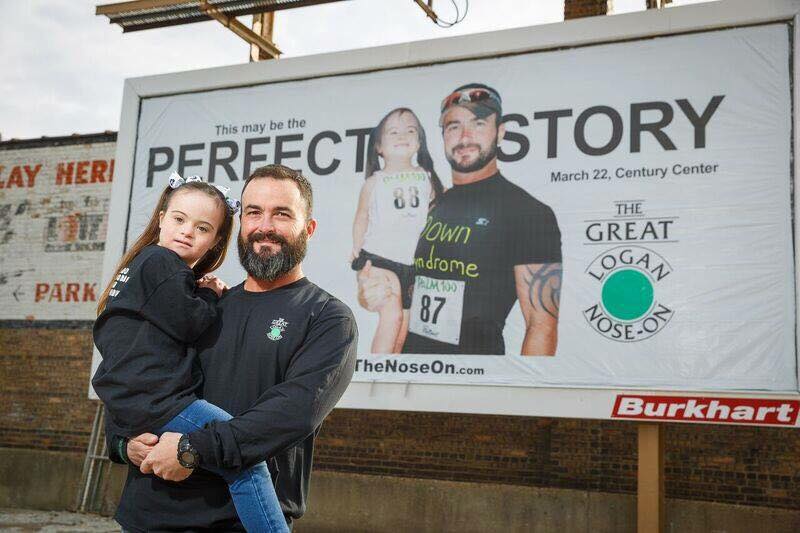
Heath’s desire every time his story is told is simple: “If I can just inspire one person. If one person hears my story and their friend has a diagnosis and they’re having a hard time with it. They might think “I remember the guy I heard about, he was complete jackass and he turned around. Let me tell them this story. If that happens just once, then it’s worth it.”
Maybe that’s you.
I’d love it if you would help me spread Heath’s story. You can use the buttons below to share this post on social media.
To get more content from These Small Wonders, click here and subscribe to the blog for updates.
by Tom Brown
The purpose of this blog is to give expression to my experience – to find some way to explain what my daughter and her disability have done for my life. She has brought massive trials and challenges into my world, but even on the worst days I wouldn’t change a thing. I am without doubt a better man and a more complete human being because of my daughter with Down syndrome.
This week I had a fresh realization of her humanizing effect.
Sunday afternoon I jumped in the car to get in a workout before the game. I turned onto the river-side drive I have taken hundreds of times to get to the YMCA downtown. As I mentally checked out of the familiar route to plan my time at the gym, I was startled back into the moment by a very unfamiliar scene up ahead.
Traffic in front of me was stopped by a person wandering down the middle of the road. A small crowd of pedestrians was gathering on the sidewalk. The person in the street was gesturing wildly while talking heads leaned out of car windows – “you need to get out of the road!” “are you okay?” etc.
I pulled up to the scene and saw that the person in the street was a young boy, I’d guess about 10. He was barefoot, unkempt and definitely did not look okay. The heads in the cars turned together for a quick planning session. A woman with a cell phone dialed 911 and I pulled around the corner to get out and try to talk with the boy.
I walked over and steered him off of the busy street. He wouldn’t look at me or respond to my questions and he took a couple of swings at me while I blocked his access to the road. As I herded him around the corner I worked through a string of options in my head. Is he in a state of panic? Having a bad day at home? Am I speaking a language foreign to him? Does he have some kind of intellectual disability?
The woman who called for help joined me and together we walked up and down the block, keeping our troubled companion out of the path of the cars. After about ten minutes, two of the pedestrian onlookers approached us with a woman following close behind. They had heard a voice down by the river calling out a name and fetched her. When she saw her runaway with us she seemed to radiate a mixture of relief, trauma and embarrassment.
She explained that the boy, her step-son, is autistic and non-verbal. She was in the bathroom and he slipped out the front door for an unsupervised expedition. As the boy is fascinated by water, the first place she thought of looking was down by the river, fearing the worst. When she wrapped up her story, the intrepid explorer sat down on the sidewalk, a police cruiser pulled up and I took my leave.
Only after leaving the scene did I consider my own proximity to the runaway experience. With a little distance and reflection it seems obvious to me, the Providence in the situation. I was the perfect person to step into that road.
Throughout the whole experience I felt perfectly calm. I wasn’t stressed or worried by the uncertainty of the scenario. I didn’t mind the interruption in my busy day or the boy’s violent attempts to take out his angst on my body. I wasn’t frustrated by the failed attempts at communication. It just felt like an interesting challenge to me. Looking back, I realize that, in that moment, I was demonstrating the product of nine years of training.
For nine years I have been living with a child who doesn’t use many words and is often intensely frustrated. I have been dodging blows and trying to puzzle out invisible needs and desires. I have been living with constant interruptions in my schedule. I am all to familiar with the act of trying to talk down an insanely stubborn and agitated child while a crowd looks on.
Sunday afternoon, without thinking about it, I adopted the posture, the patience and the creativity I have learned in adaptation to an unpredictable life at home with my daughter.
The unruffled composure of that moment – it’s one of the many benefits I have received through my daughter and because of her disability. Naturally I am an anxious person who tends to be a little jumpy, especially around nonverbal strangers gesturing wildly in the street. But things have changed.
The Development of Anti-Fragility
There is a word for this new quality in my life – it’s what statistician and risk-analyst Nassim Nicholas Talib calls anti-fragility. Anti-fragility is the precise opposite of fragility. It’s not resilience. Resilience is a kind of strength which endures despite stress and difficulty. Anti-fragility doesn’t just tolerate stress, it benefits from it. It grows and thrives because of the stress. (Picture the mythical hydra which responds to the stress of losing its head by growing two more in its place.)
A person who is anti-fragile meets unexpected difficulties as benefactors and gains power and stability from them.
An anti-fragile person sits in a doctor’s office while their child shouts with hysterical rage and flails savagely at the impertinent strangers who are attempting to shine a bright light in her eyes and walks away from the experience having leveled up in courage. The first time is horrifying. The second time a little less so. You go through enough experiences like this and you realize they’re not going to kill you. They just kind of become routine. And along the way, without realizing it, you are becoming more and more anti-fragile.
This is something I have come to admire in parents of children with disabilities. There is a tolerance for the chaotic and the unpredictable that is uncommon and heroic. I have often watched with silent respect as a parent calmly and creatively handles a pickle of a scenario which would cause the average person to flip their lid.
It’s important to say what I am not saying here. I am not claiming an angelic or supernatural tranquility that breezes through life several inches above ground and untouched by circumstances. We have very bad days in my house, days with new challenges and new recurrences of old challenges that make us want to throw in the towel. What I am saying is that those days we dread so much don’t weaken us, but tend to have the opposite effect. The bitter buds of difficulty and disorder grow up into the sweet flowers of toughness and tenacity.
Talib laments the tendency we have in our modern world to mitigate risk and eliminate variables. Experience shows us that the more we attempt to control our world, the more fragile we become. This isn’t a problem for most of the parents I know who are blessed by disability in their offspring. There’s a point that comes pretty quickly when you give up. You can fight the wave or you can turn around and ride along. There will be no control.
Your child will throw an iPad into the washing machine to take a spin with the whites. She will gleefully stick her face into the perfectly frosted cake you’re about to take to an event. She’ll throw her glasses onto the basketball court during her brothers’ basketball game and her road ID into the lions den at the zoo. She’ll slap the new person sitting next to you at church in the face, take a sip of their coffee and then chuck her bowl of Chex Mix into the next pew when she decides snack time is over. There is no predictability. There is no control. There is only chaos and surrender.
And that surrender to the chaos is the beginning of our anti-fragility.
Don’t you think we all could use a little more anti-fragility in this crazy complex world of ours? For that and a thousand other things, I thank God for my unpredictable little girl and salute my fellow anti-fragile parents. And I pity the inevitable fragility of the family or society which chooses to eliminate a potential source of disorder and strain in the misinformed belief that they are securing control over life.
“Courage is more exhilarating than fear and in the long run it is easier. We do not have to become heroes overnight. Just a step at a time, meeting each thing that comes up, seeing it is not as dreadful as it appeared, discovering we have the strength to stare it down.” –Eleanor Roosevelt, You Learn by Living

by Tom Brown
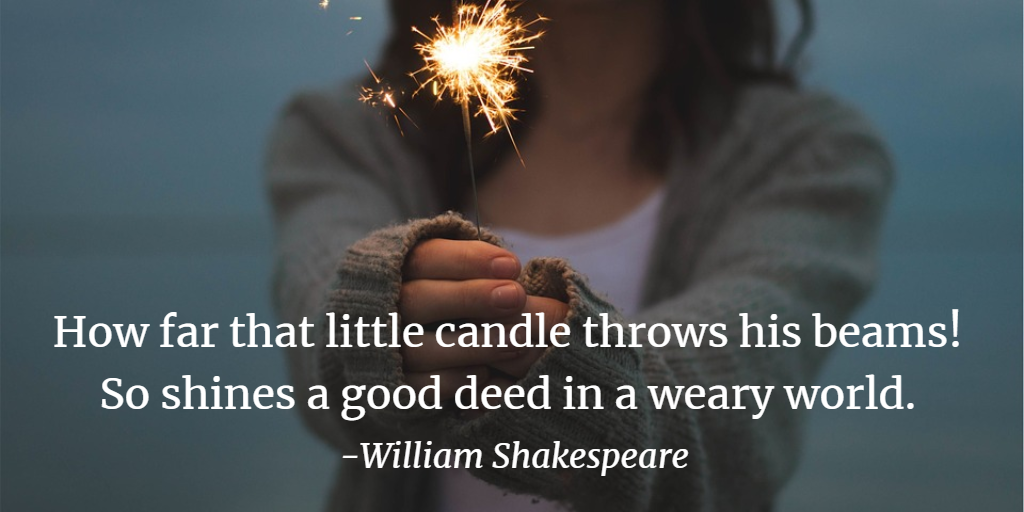
Maybe you saw the scene last week.
The camera pans through a crowd of yellows shirts glued to screens mounted on the wall – Colombia is playing Poland in the group stage of the World Cup. The camera stops to rest on a table where two men sit around a makeshift field. The men are holding hands, moving them around the model field together – one man looking down, intently concentrating on the movement of the hands. The other man’s head swivels back and forth from the screen to the table.
The text at the bottom of the screen explains what is happening – one of the men, Carlos Junior, is blind and deaf. The other is using a complex system of tactile communication designed to help his friend experience what he can’t see or hear. The ingenious system allows Carlos to follow the movement of the ball on the field – even small details like a shot on goal deflected by a cross bar, or the dramatic flop of a player to the ground. The atmosphere around the two men is electric. As the video closes, the bar erupts with the sounds of a Colombian “ggggooooolllll” and the sight of two elated men jumping up and down in each other’s arms.
It’s a moving experience watching this act of friendship. The millions who have viewed it agree. It’s something that is hard to describe. It’s as if the joy of a man given the chance to forget his limitations and for a brief moment share in the revelry of the human experience around him is a tangible thing. It rises up out of the screen. It resonates through the air and into your soul. And the love in that moment? I’m not crying, you’re crying.
What is that?
The Science of a Good Deed
Whence comes that feeling, that wetness on your cheek when you see something like this? Psychologists call that elevation, it’s the positive neurological and emotional effect of witnessing a kind or inspiring deed.
In 2010 a group of scientists carried out a study to test a hypothesis about elevation. Psychologists Simone Schnall, Jean Roper and Daniel M.T. Fessler believed that people who witness uplifting scenes enter a state of elevation and are more likely to participate in what they call “pro-social behavior.” They are more likely to be decent human beings.
They wanted to test what seemed to be an obvious idea against data. There were two phases of the test.
Phase One. A group of participants were shown one of two video clips – the first a pleasant scene from a nature documentary. The second was an uplifting scene showing a kindly act. After watching one of the clips, participants were asked to volunteer to help with another study. Those who watched the uplifting scene were more likely to give away their time. The data concurred with the hypothesis – the elevated ones were the giving ones.
Phase Two. On the way out of the lab, participants passed by a research assistant who appeared to be having trouble with a computer. The elevated participants spent twice as long as the other participants trying to help the assistant. Once again, a win for the hypothesis.
Conclusion. Here’s the final word from the team: “these results provide evidence that witnessing another person’s altruistic behavior elicits elevation, a discrete emotion that, in turn, leads to tangible increases in altruism.” In other words, it only takes a small exposure to others doing good deeds to elevate your mood and motivate you to act unselfishly.
Results like this suggest that a couple of minutes spent watching two friends taking in a football match has elevated the mood of millions of people in a way that substantially increased their likelihood of acting in kind and unselfish ways. How far that little candle throws his beams.
But that’s just the beginning.
Oxytocin and Antibodies
Not only does the elevation that comes from witnessing an inspiring deed lead to more inspiring deeds, studies show that the experience has a significant effect on your body’s health.
For example, a group of students asked to watch a video documenting Mother Teresa’s work in Calcutta experienced substantial increases in protective antibodies, providing a defensive boost to the immune system. This effect lasted for an hour after watching the video.
Other studies show that exposure to good deeds produced elevated levels of oxytocin, a chemical which reduces stress and promotes healing. You’ve probably heard of the fight-or-flight response produced by adrenaline. Oxytocin is a balancing counterpart of adrenaline. It creates what scientists call the tend-mend response – it calms us and creates a sense of trust.
An Uplifting Cycle
Dr. Stephen G. Post, professor of bioethics at Case Western Reserve University, has been studying this effect for years. Post describes what he calls a ‘compassion-altruism axis’, a region in the brain that fires during moments of compassionate or empathetic emotions. When this part of our brain is active, it creates “a profound state of joy and delight”. It reinforces activity that fills the world with altruistic love.
What Post has found is an uplifting, elevating cycle. You see a good deed and you feel better. You’re less stressed, you have a heightened awareness of the people around you and you’re more likely to act when you see them face a challenge. That action in turn makes you (and everyone else in the room) feel better, less stressed, more likely to help others, etc.
One good deed throws a far beam.
Disability and Inclusion in the Mainstream
For those of us with disability in the home, this is a familiar story. Elevation is a daily experience.
It happens when I see my weary wife sitting on the bathroom floor at the end of a long day, patiently working towards her daughter’s independence. It happens when I see my insanely active sons slow down to carefully decipher their sister’s words and help her find the show she is looking for. It happens when my little girl proudly walks into a room brandishing a handful of fresh picked flowers she collected for me.
Every day in my home I see people happily give themselves away to help someone who has more needs than they do. I see a little person with all those needs courageously fighting to overcome her limitations and reach new heights. I practically live at a state of elevation, soaking in all of those life giving benefits that come with it.
And here’s the thing – wherever Elizabeth goes, she brings that with her. Into a classroom, a reading group at the library, a church service or the grocery store – uplifting scenes follow behind her and the world around her is elevated. She is dropping her pebbles into the pool of humanity, sending ripples of compassion and empathy cascading out into the world.
This is why the rise of inclusion of people with special needs in our society is great news for the mainstream. Every kid with special needs in a typical classroom, every girl with Down syndrome on the cheer-leading squad, every one of those blogs and social media accounts flooding our screens with uplifting stories – they are also flooding the world with stress-relieving, life-prolonging, good-deed provoking elevation. They are reinforcing the bonds of altruistic love that bind our human family together. (And aren’t we desperately in need of more of that reinforcement in this rapidly polarizing world of ours?)
The data suggests that making space for people with special needs in the mainstream benefits the rest of us far more than it does them. They are helping us become healthier and more decent human beings and the immeasurable benefit is far outweighing the costs.
The science is clear: inclusion of people like Carlos Junior and my little girl is changing the world.
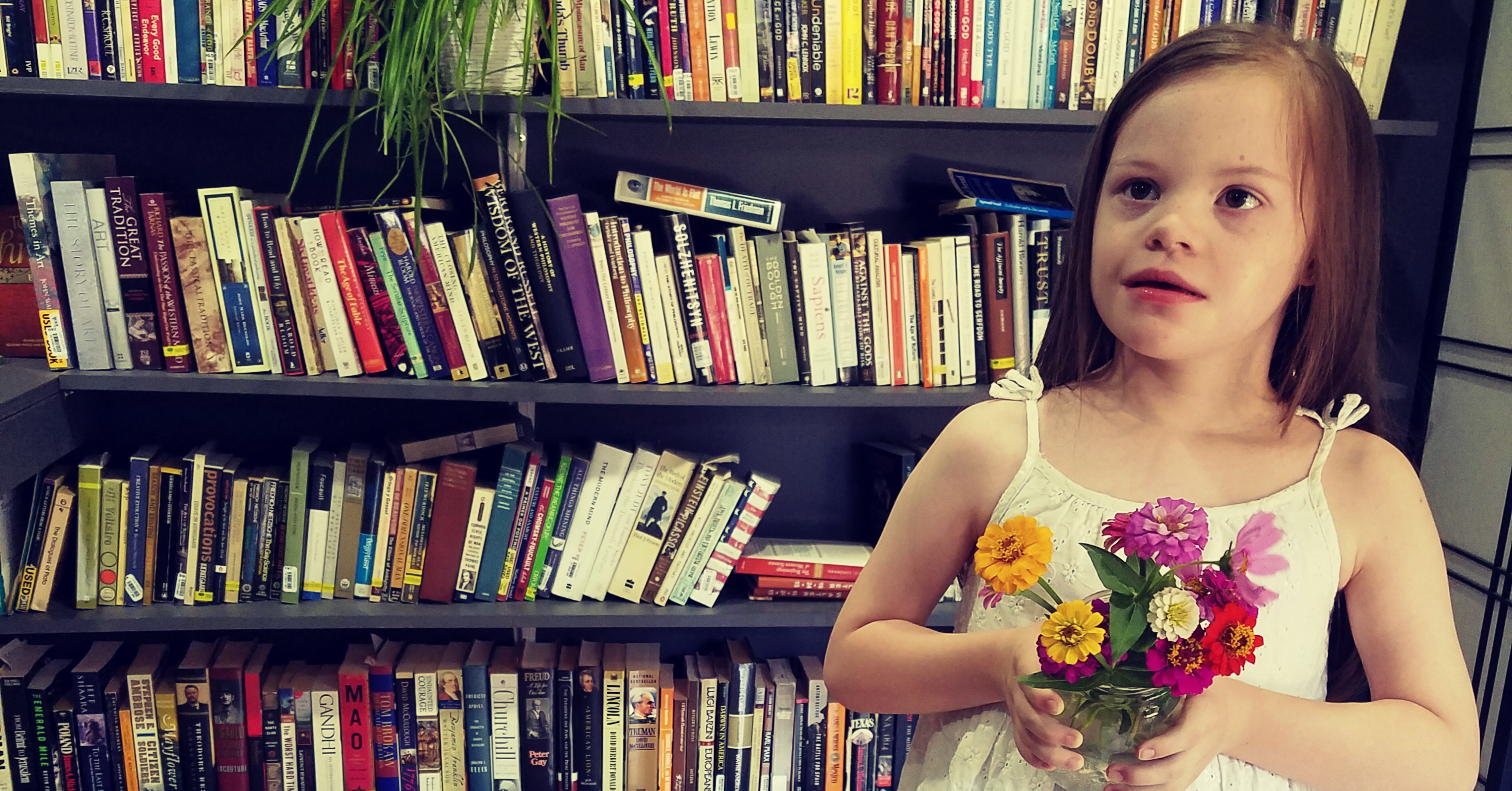
by Tom Brown
How do you measure the worth of a life?
Last year a Dutch man sat at a table with a Danish filmmaker to have a talk about perspectives. The man is Sjoerd, a portly guy who appears to be in his 40s with an amiable, thoughtful face. You like him immediately. He begins the conversation with a question – “I have Down syndrome, what do people in Denmark think about me?”
This should be interesting. In Denmark, 98% of pregnancies testing positive for Down syndrome end in abortion. And almost every pregnancy is tested.
Have you ever had to wonder what an entire country full of people might think about you?
Apparently Sjoerd has and he is about to get an answer. His Danish interviewee, a fine specimen of a healthy Northern European, responds that in Denmark people with Down syndrome are like windmills. It’s a wonderful idea – we like them, he says. But one in our back yard? No, too ugly. And the noise! It’s not for us.
You see, he says, in Denmark we don’t want Down syndrome in the back yard. “It conflicts with the idea of perfection, the perfect family, the perfect child.” A third man, observing the conversation, remarks to Sjoerd – “apparently you don’t meet that picture of perfection.”
Sjoerd’s response? “Yeah. I don’t know how to react to that.”
Me either, man.
Wow. How do you react to that? There is a whole country where people like you aren’t wanted. They are aiming for perfection and, you understand, you’re not it.
You feel for Sjoerd. Especially when you have a daughter just like him.
When there is someone in your life like Sjoerd or Elizabeth you are often forced into meditations like these – what would the world be like without people like my child? Can I justify her existence to society? Will the world some day be without people like her?
These questions concern me. I am deeply concerned. But not for my daughter. For the rest of us.
A Growing Concern
I’m concerned about what we would become without her. And, more specifically, I’m concerned about what we would become because we chose to be without people like her. What does it do to us to make a decision like that?
It’s almost heartbreaking to watch Sjoerd process what he has heard. “I’m not perfect. That’s not what I am saying.” Your heart is twisted to the verge of breaking because you are witnessing a deeply wounded man trying to justify his own existence. I admit that I’m not perfect, but if you give me a chance, I have my own kind of beauty.
It’s such a strange time for people with intellectual disabilities and their families. On one hand, it’s a beautiful time. There is more inclusion, there are more resources than ever before. The body of medical knowledge is growing rapidly. PR for Down syndrome is trending through the roof.
Yet, for all that, the numbers show that we just don’t really want those people in our back yard.
We continue to like and share their stories on social media while at the same time continuing to develop better ways to find them in the womb before they have a chance to sneak into our back yards.
This is something that for most of my life was largely irrelevant. Maybe it is for you as well. But when you’re holding your precious child in your arms and hear that 90% of people like her who are discovered in the womb will not be born – you’re kind of forced to think about these things.
That number I heard 8 years ago has been under some debate, and recent studies now put it at around 70-75% of pregnancies in the US. I’m happy to see that smaller number, but it’s still alarmingly big. And it’s much larger around the world. In the UK it’s 90%. In Denmark 98%. In Iceland the number is approaching 100%. In China, the most populated nation on the planet, the termination rate is 95% and selective abortion for disabilities is legal up to 9 months in the pregnancy.
I’m happy that my daughter was born into a social moment in which she will be celebrated. Maybe she will be a model, or a prom queen or a beloved neighbor in the dorms of a college campus. Shoot, at the rate we’re going, she might even be President someday. I’m very happy about that.
But I’m not sure how long this moment will last. It’s those numbers that keep me awake at night. I’m worried, but not just for my daughter or people like her. I’m concerned for our civilization.
What does it do to a society to decide that some humans are not worthy of life, to decide to deny existence to an entire class of people for the sake of the greater good? What does it do to the one who wields that power?
What is the consequence when the worth of a human life is measured by it’s attractiveness to others, it’s production to society, it’s ability to conform to its’ society’s standards of perfection?
The question isn’t entirely speculative.
An Example from History
There is a museum in Berlin called the Monument to the Murdered Jews of Europe – it’s an instrument of education, designed to give a history lesson in the inhumanity humans are capable of. In the museum there is a long, roundabout wall covered in photos, newspaper clippings and historical notes. I will never forget what I saw half-way through my journey at the monument.
Up to that point it was just surreal. This is so insane, it’s so unbelievable that I can’t process the reality of it all. It’s not really hitting home. Until I see the word disabled. There’s a section on the treatment of people with disabilities and I am no longer numb.
In the early days of Nazi power, health departments worked with police, psychiatrists and other social departments to create a registry of disabled people. Those on the list were sterilized or institutionalized. They were “ballast existences” – they diverted provisions needed for the more productive segments of the population.
Things escalated quickly from there and in October of 1939 Hitler issued an order for the murder of those on the registry. Action T4, it was called. It was billed as a process of euthanasia, merciful death. As in, ‘don’t worry friends – we’re just doing them a service, a mercy, by ending their suffering. It’s for them.’
Behind the scenes though, the real purpose of Action T4 was to rid Germany of “useless eaters” – 200,000 mentally disabled persons. But they didn’t just kill them, they made them useful. Many of those non-producing consumers were first experimented on by men like Albert Widmann. He was a chemist who tested killing gasses, drugs and poison ammunitions on the disabled at the “euthanasia” camps, those houses of mercy.
Action T4 quickly grew into the infamous system of concentration and extermination camps which carried out the Nazi final solution, the creation of a more perfect humanity.
What does it do to a society when they decide that a particular class of individuals is a hindrance to the pursuit of the common ideal and therefore eligible for sacrifice?
It Changes Us
After the monument in Berlin, I visited a place called Sachsenhausen, an hour drive from the city. Sachsenhausen was one of the first concentration camps in Nazi Germany. At the camp, one of the few original buildings still intact is the main guard tower. Seventy five years ago young men stood in that tower looking out over the fields and buildings in which they oversaw the horrific experimentation, the torture and murder of a class of people who were deemed unworthy of life.
The tower is now a museum which houses a collection of files. They are biographies of the young men who left their mothers and their homes in the villages of Germany to become soldiers of the SS, servants of the glory of the German ideal. The files contain the stories of ordinary young men who were shown a vision of perfection, handed the knife-blade of selective “euthanasia” and became monsters of inhumanity in the process. One decision at a time. The collection is a clear warning.
When a social ideal takes ultimate priority, when non-ideal individuals are sacrificed on the altar of that ultimate priority, bad things seem to follow. Decisions like that change people, they change a society on a fundamental level.
Are We Different?
It seems strange to compare a society which crowns girls with disabilities as prom queens to the Nazis and their final solution. But the statistics force us to admit that we might have more in common than we would like to believe. There’s more than one way to create a society which consumes its individuals. There’s the obvious ones – the brutally cold, oppressive violence of 1984 and the Nazis. And there are more subtle varieties, like the pleasantly intoxicated, blissfully distracted and genetically engineered beautiful people of a Brave New World. Entirely different on the surface, peel back the skin and they are identical. Both are the result of an effort to reshape humanity according to a social ideal, the image of a perfect world. Both are a society without a soul.
How about us?
Do you think my daughter is cute? Wonderful! Me too.
But do you think she is worthy of life? Should you or I or any one else have the power to make that determination?
Doesn’t this seem like a question that deserves some serious thought?
What if there is more to life than relentlessly chasing after perfection? What if we are all hopelessly imperfect and our social archetypes of the perfect life are empty promises? What if the ideal form of our humanity is bound up in things like grace and mercy and compassion – and don’t we risk those things when we choose to sacrifice a population who isn’t perfect enough for us – who ask too much of us?
Maybe we are so prone to self-centeredness and greed and pride that we need a strong corrective medicine. Maybe we are a little bit like those carts in the grocery stores, those crooked-wheeled swervers that need a constant corrective nudge in the right direction to keep moving forward. And maybe Sjeord, that beautifully imperfect Dutchman, is just the corrective we need.
Sometimes I look at my daughter and it’s as if some form of unspoken, telepathic communication is taking place – soul to soul. I’m imperfect, I’m needy and dependent, and I can save you. I will teach you what it is to have compassion, to love without condition. I will show you the irrepressible joy of authentic, unaffected imperfection. I will bestow upon you the invaluable treasure of grace for the undeserving. I will show you what it means to be human. Every time a baby with Down syndrome enters our world, whether they sneak in the back or find an open front door, they bring this message.
Maybe we can only truly be human together with people like my daughter and Sjoerd. Maybe that profound mystery Desmund Tutu saw in our racial differences is also true for our differences in ability:
“Our humanity is bound up together, for we can only be human together.”
I believe it is. That’s why I write. I believe my daughter can save our humanity.
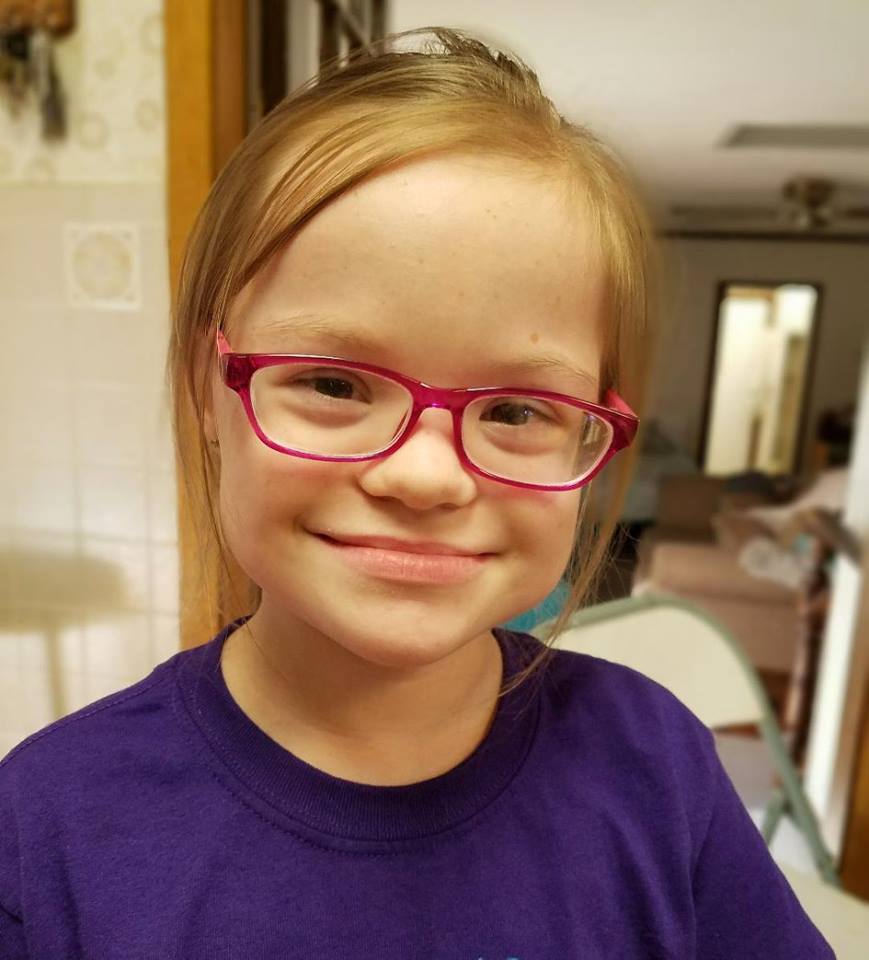
by Tom Brown
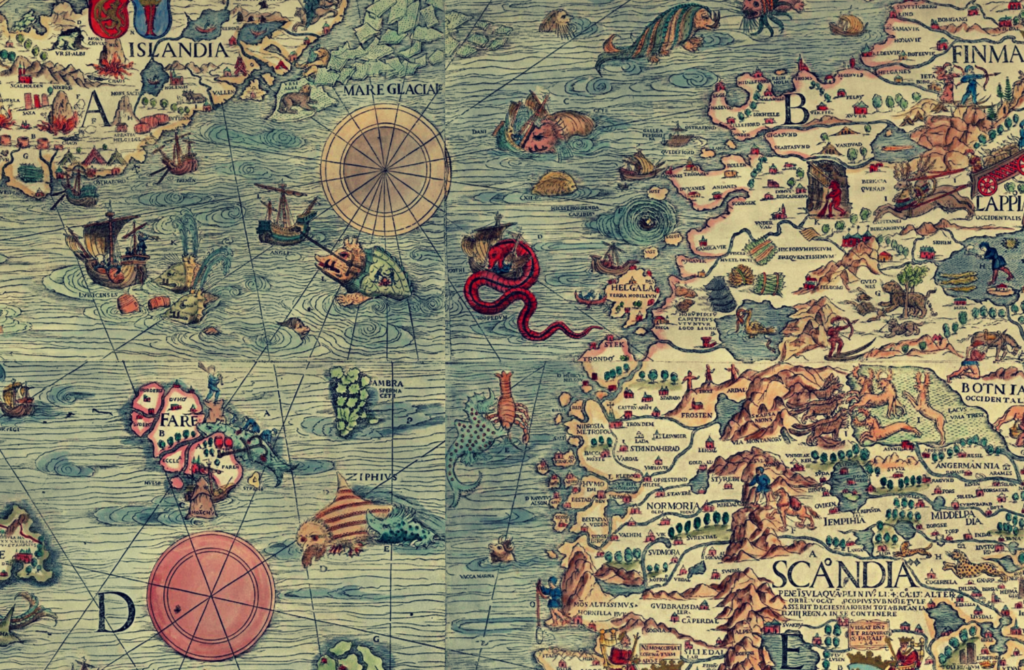
How much life have we left unlived because of fear?
This morning I ran into a man I know at the YMCA. His name is Charlie, we met when he visited my church a few months ago. He looks like a pretty typical young millennial guy – he’s got a trim physique, a bit of facial hair, some slim fitting clothes. He also carries a walking cane because he is totally blind.
You can imagine the feeling when I saw him coming up the stairs into the weight room at the Y. He strolled right up those stairs, across the running track and through a maze of machines, benches, weights and weight-lifters. Just like it was the easiest thing in the world. I walked over to say hi and he casually asked if I could point him to the 55 dumbbells and an open bench.
I was not the only one who watched with barefaced respect as Charlie worked his way around the gym for a standard chest routine, stopping every now and then to ask whoever was listening for a hand or an eye. We were all asking ourselves the question one of the guys couldn’t keep in – “what’s our excuse?”
How does someone develop that kind of courage?
I’ve been thinking about fortitude. About fear and risk.
A few weeks ago I heard a seminar illustration about an old practice of map-making. In the age of explorers a globe marked an uncharted territory with these words: hic sunt dracones. Here be dragons. It was a spin on the ancient map-making practice of using lions (lions abound here!) and other frightening beasts to symbolically mark the threat of unknown dangers. A traveler who read the map would be warned – you don’t want to go there.
When I heard the dragon talk I instantly recognized a modern parallel. The old warning is recreated countless times, in sterile offices around the world when expecting parents are shown their version of the map – the one with an ugly dragon drawn over the word ‘disability’. You probably don’t want to go there – there are dragons. You’ll lose your life, the burden of risk is too great!
It’s one of the deepest, darkest fears in the heart of a potential parent – a child with broken genes. It’s one of the worst things you can imagine happening to you in life, a place at the edge of the map where no one wants to go.
Mandy and I first saw the map during our 4th pregnancy. A few months in, preliminary tests came back positive for a risk of Down syndrome. It was a shock to say the least. A real jolt to the nervous system. Neither of us had any experience with the disability, we just knew about the dragon on the map. You don’t want to go there. You don’t have to go there, they told us. We scheduled an appointment with an ultrasound technician who reassured us that everything was normal. False alarm. Whew. Wipe the brows and sail away from dragon-land as quickly as possible – back towards comfort and security.
Or not.
Just as soon as we escaped, a gusting wind caught our sails and blew us right back crashing into the shore. Right into the delivery room and the arrival of our little girl with her slanting, almond eyes.
What now? What dangers are lurking here to bring certain death?
In time we recovered from the crash and ventured in-land. Maybe we can find others who have landed here. We made some friends who helped us get acquainted with our new home, we found a few pieces of travel literature and felt our way forward. It was difficult. There were burdens. That is certain.
But even in those first days we were surprised by the things they, those map makers, did not tell us about.
We were surprised to discover how much love we felt for our little burden. Is it really possible to feel this much emotion? We were surprised by the immediate and overwhelming acceptance she was surrounded with by friends and family and people we hadn’t heard from in years. Can people really be this kind, this good? We were surprised by the adamantine resolve we felt emerging within our chests. Where did this strength come from? Most of all, we were surprised by the inexplicable little joys we encountered on a daily basis as our daughter’s delightful, unpredictable, thoroughly unique personality began to emerge. She is captivating.
This is the dragon-land? This is the terrible, horrendous land of beasts and certain death?
What kind of map is this?
Sure there’s some rough terrain here, but there’s some incredible scenery you can’t find anywhere else. A person could live here.
We learned quickly that we had to start from scratch. The old rules of navigation no longer work here. The compass lines of comfort, safety and care-free independence give no bearings. Here direction is determined by necessity and love. It’s not about “what will make me happy and comfortable?” but, “what does my child need?” What does love require? You have to grow up here. It’s no longer a question of what-might-happen, but it has happened and what the hell are we going to do with it? It’s thin air to breathe, for sure, but the lungs adapt and the chests expand.
Something happens to you when you get thrown into a place like this. Before you know it, fear gradually transforms, transmogrified into resignation, then strength, and finally a determination to make the most of what’s around you and get to living. To start loving and giving your life away.
That’s the thing about Charlie. When you’re blind, every place is a bit of an unknown. Every trip is filled with risk (I stepped in at one perilous moment to narrowly save his shins from a gnarly curl bench.) When you’re blind everything is harder and more costly. It’s just life. And you can either stay home on the couch or you can get up and dare the journey and live your life.
This is one of the gifts our atypical kids come bearing. They bestow the blessing of facing down the unfamiliar, the terrifying, the this-looks-like-it-could-kill-me and living to tell the tale. They come with keys to unlock the life-sapping shackles of what-might-happen anxiety.
There is a kind of courage and inner strength that can only come through experiences like we’ve had. I stumbled into a territory renowned for its hazards and I survived. I adapted and grew and even learned to thrive. I found other intrepid jungle voyagers and together we are gaining strength, making a way, making our own maps.
Here is what I have learned in this place. This is my report.
There are dragons. There are lions. But we are the dragons and lions. We are the ones who develop thick-as-scales-skin and muscle-lined wings. We are the ones achieving the powers of flight, who challenge the winds and rise through the obstacles and difficulties to soar at great heights with grand, sweeping vistas. We are the ones sitting on shining treasure stores of joy we have mined from out of the hard earth.
We are the kings and queens of this untamed jungle, the undaunted ones who have confronted the threatening void of the unknown and no longer fear the darkness.
Do you think a woman who has potty trained a child with Down syndrome is afraid of anything?
The storms have cast us into this unexplored territory and we have survived to send the report – it’s wild in here. It’s difficult, demanding, sometimes harsh and punishing. But it’s good. There’s life here for the brave ones. There’s life to be had that cannot be found in the mainstream. But to live here, you’ll be changed.
To Charlie and all my friends carving out a life in this place, let me speak this word to you – you are lions. You are heroes. You may not feel that way sometimes, but to survive in this place requires heroic levels of love and persistence and courage. It requires heroes.
To those newly arrived on our shores, who are disoriented and never wanted to be here: forget what you’ve seen on the maps, don’t let others define your child or your life for you. Gather your courage and come fly with us. You’re about to find out what you are made of.
Things are changing in 2018. Our land is no longer defined by the inaccurate and threatening drawings of timid and unknowing map-makers. We are telling our own stories. We are making our own symbols. We are exporting to the world the riches of our land.
Yes here be dragons. And lions abound. Welcome to our jungle.
